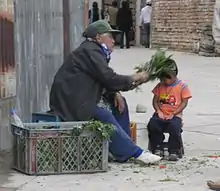Folk healer
A folk healer is an unlicensed person who practices the art of healing using traditional practices, herbal remedies and the power of suggestion. A folk healer may be a highly trained person who pursues their specialties, learning by study, observation and imitation. In some cultures a healer might be considered to be a person who has inherited the "gift" of healing from his or her parent. The ability to set bones or the power to stop bleeding may be thought of as hereditary powers.

Granny women
Granny women are purported to be healers and midwives in Southern Appalachia and the Ozarks, claimed by a few academics as practicing from the 1880s to the 1930s. They are theorized to be usually elder women in the community and may have been the only practitioners of health care in the poor rural areas of Southern Appalachia. They are often thought not to have expected or received payment, and were respected as authorities on herbal healing and childbirth. They are mentioned by John C. Campbell in The Southern Highlander and His Homeland:[1]
There is something magnificent in many of the older women with their stern theology – part mysticism, part fatalism – and their deep understanding of life. ..."Granny" – and one may be a grandmother young in the mountains – if she has survived the labor and tribulation of her younger days, has gained a freedom and a place of irresponsible authority in the home hardly rivaled by the men of the family. ...Though superstitious she has a fund of common sense, and she is a shrewd judge of character. In sickness she is the first to be consulted, for she is generally something of an herb doctor, and her advice is sought by the young people of half the countryside in all things from a love affair to putting a new web in the loom.[1]
White witch
White witch, and good witch are qualifying terms in English used by some to distinguish practitioners of folk magic for benevolent purposes (i.e. white magic) from practitioners of malevolent witchcraft or black magic.[2]
During the Witch trials in Early Modern Europe, many practitioners of folk magic who did not see themselves as witches, but as healers or seers, were convicted of witchcraft (Éva Pócs' "sorcerer witches"): many English "witches" convicted of consorting with demons seem to have been cunning folk whose fairy familiars had been demonised,[3][4] and over half the accused witches in Hungary seem to have been healers.[5]
Some people accused of witchcraft have described their experiences as contacting fairies, spirits, or the dead, often involving out-of-body experiences and travelling through the realms of an "other-world".[6] Beliefs of this nature are implied in the folklore of much of Europe, and were explicitly described by accused witches in central and southern Europe. Repeated themes include participation in processions of the dead or large feasts, often presided over by a female divinity who teaches magic and gives prophecies; and participation in battles against evil spirits, "vampires", or "witches" to win fertility and prosperity for the community.[6]
Popular culture
- Sir Walter Scott spoke of a "white witch" in his novel Kenilworth (1821)
- The "white witch" Glinda is the Good Witch in L. Frank Baum's The Wonderful Wizard of Oz and the film based on it.
- C.S. Lewis inverted the image of "white" witchcraft as "good" in his children's book series The Chronicles of Narnia, naming one of his primary villains The White Witch.
- Terry Pratchett featured white witches as protagonists in many of his Discworld novels. He also depicted them as fairy godmothers and de facto royal wizards (despite their gender).
See also
References
- John C. Campbell, The Southern Highlander and his Homeland, Russell Sage foundation, 1921, pg. 140. https://archive.org/details/southernhighland00camp
- "There were a number of interchangeable terms for these practitioners, 'white', 'good', or 'unbinding' witches, blessers, wizards, sorcerers, however 'cunning-man' and 'wise-man' were the most frequent." Macfarlane 1970 p. 130; also Appendix 2.
- Emma Wilby 2005 p. 123; See also Alan Macfarlane 1970 p. 127 who notes how 'white witches' could later be accused as 'black witches'.
- Monter () Witchcraft in France and Switzerland. Ch. 7: "White versus Black Witchcraft"
- Pócs 1999, p. 12
- Ginzburg (1990) Part 2, Ch. 1.
Sources
- Keith Thomas, Religion and the Decline of Magic (1971), p. 534.
- Ryan Stark, Rhetoric, Science, and Magic in Seventeenth-Century England (2009), 123-27.
